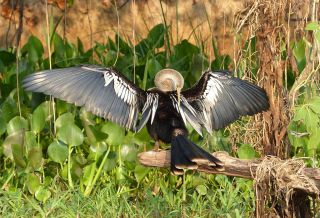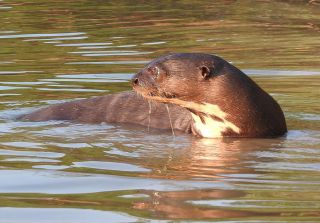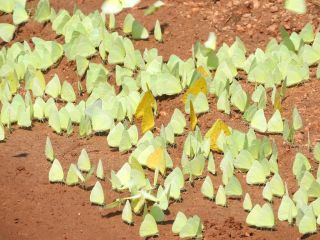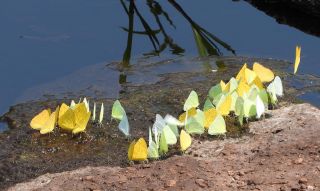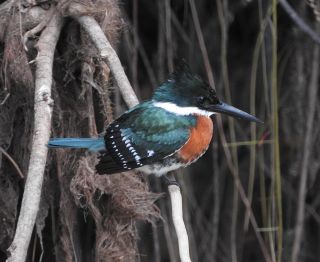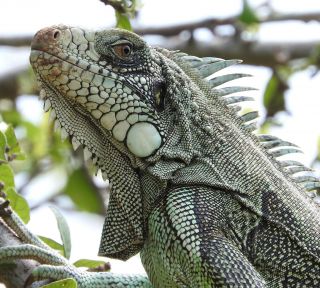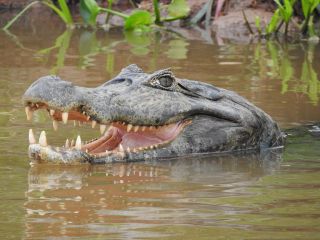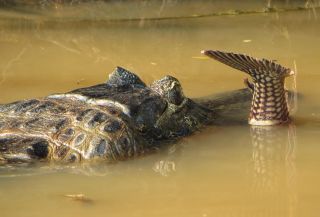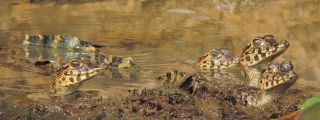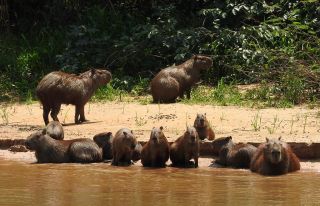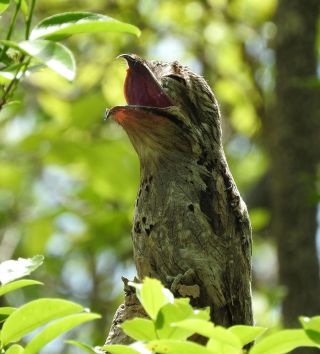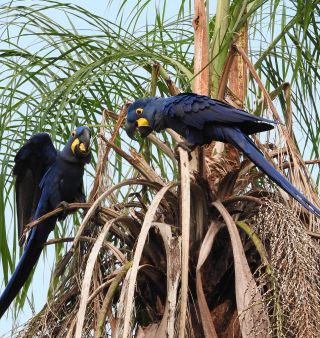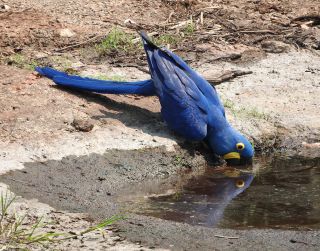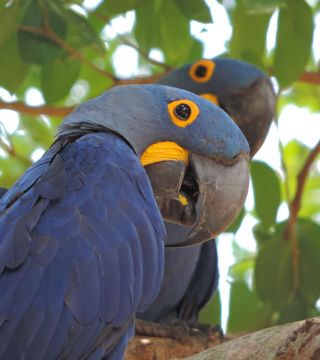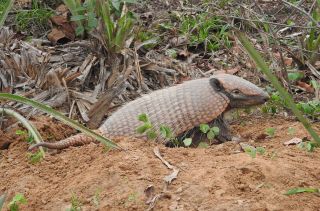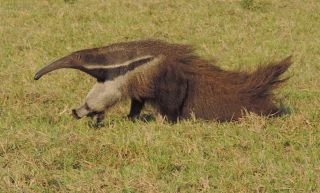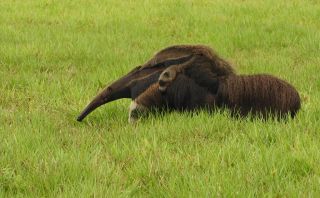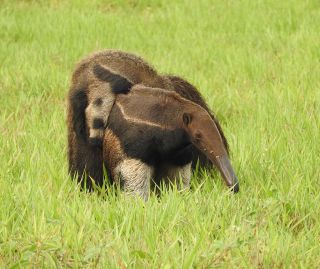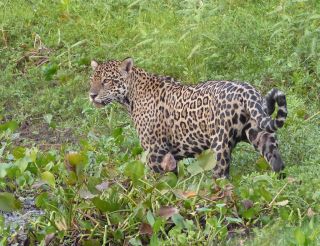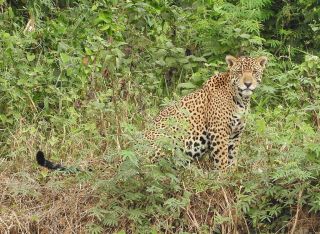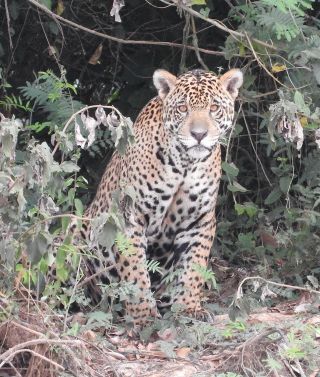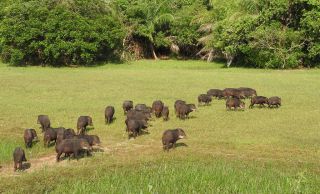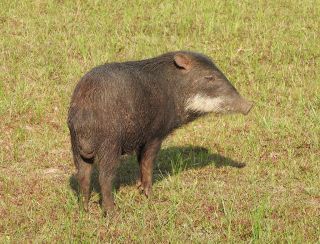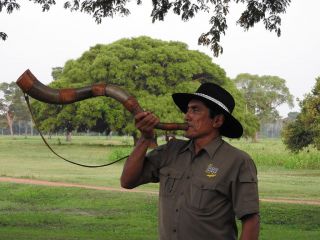Anhinga airing its wings and preening © Mark Brazil
Life at the Water's Edge
By Mark Brazil | Dec 31, 2015
An Anhinga, a lanky relative of the ungainly cormorants, lounges in a riverside tree with its wings spread broadly catching the morning sunshine. When the fishing urge takes it, it unhinges itself from the overhanging branches, belly flops down into the river with a splash as if on its first day at the pool, but it submerges instantly more impressively like a pro than a drowning novice. Moments later, like a bizarrely feathered submarine raising its periscope from the muddy river waters, a long, slender, kinked neck, topped by an elongated head and bill appears. The Anhinga's thin neck slices through the water’s surface, cutting through it and into the air like Lyra Belacqua’s Subtle Knife cutting between worlds. The bird’s periscope submerges once more, leaving no ripple behind, as the Anhinga goes into stealth mode – hunting beneath the water’s surface.
A lucky quest later, bill, head and neck re-emerge, this time with a fish speared crosswise on its bill. Where its cormorant relatives grasp fish for easy swallowing, the Anhinga spears its prey through the body, forcing it into a nifty trick – it must flick its wounded prey into the air and catch it to swallow. Like sleight of hand, this is no easy trick; I have seen Anhinga fail, their flick too vigorous, their catch fluffed, and their fish escape to swim away, though surely they cannot survive with a gaping wound right through their bodies.
Nearby, gangs of pugnacious Giant Otters squeal and mouth off at each other. They squabble like angry teenagers, and move in a mob in the shade and shallows of the riverside. Each has a face seemingly so bent out of shape and with cauliflower ears that they resemble aquatic bare fisted boxers. The mothers and aunts drag, push and carry their kits so that they keep up when the gang moves off.
The otters, like the Anhinga, are in pursuit of piscine prey, but when they make a capture their reactions could hardly be more different. Grunting, crooning, squealing and moaning in apparent delight, they grasp the fish in their front paws and crunch down audibly on their food. Yes, I did say crunch. Many of their prey fish are bony and heavily scaled, and Giant Otters have a predilection for showing off their prey at their picnic sites as they gnaw and bite turning their heads and bringing their carnassial teeth into play. Along with the caiman they are among the mightiest predators in the river, but they too are at risk, they too may become prey.
Jaguars stalk these forests, wetlands and riverbanks, and when a larger predator, such as a jaguar comes on the scene, the Giant Otters first fall silent, lunge upwards pushing their forequarters up and out of the water to peer about in search of the scent of danger. Then the otter gang gathers closer, calling at and mobbing the Jaguar, doing their best to intimidate this region’s true top predator in the hope of forcing it to give up its hunt.
Sharing these same waters with its larger relatives, the Neotropical River Otter lives a more solitary life than its noisy neighbours. They swim quietly, keeping to the river’s edge, preferring the tranquil side streams; keeping themselves to themselves. On lucky occasions they can be seen quietly grooming on a semi-submerged log beside the riverbank. They slink from the water to spraint onshore or on a fallen tree trunk, marking their territories with a gelatinous and fish-scale filled dropping carrying their own scent signature. These spraints are an individual’s personal identity mark, working like a tracking signal, allowing individuals that don’t meet to know who and where other individuals are. We track each other using mobile phone Apps; otters track each other with their spraints.
When not dodging each other or prowling jaguars, Giant Otter and Neotropical River Otter must remain ever watchful. On sandbars in the river, bulging-eyed Jacaré Caiman lie immobile, sunning, just as their ancestors have for more than 80 million years. Their more distant relatives the Pseudosuchia of the early Triassic have been doing so for more than 250 million years, and that is more than an entire cosmic year – the time it takes for our sun to take a turn around the centre of the Milky Way! Now that is a really, long time. So successful is the general Crocodilian body form and predatory lifestyle that they have changed very little over those intervening millions of years. Theirs is the infinite patience of the reptilian predator, distilled over an immense evolutionary timescale. They lie endlessly in wait, lapped by shallow waters, or warmed by the sun, for sooner or later mammal, reptile, bird or fish will accidentally approach too close for safety and be on the receiving end of a wide-jawed snapping bite. Once caught in the steel-clamp-like grip of their teeth and jaws their prey has little chance of escape. Bones and scales crunch, blood flows; eventually, drained of energy the prey will be thrashed into pieces small enough to be swallowed or positioned lengthwise in the jaws so that it can be gulped down whole. There is no nicety here, not well-mannered chewing of mouthfuls, instead the prey is gulped down whole or in large chunks and the caiman’s stomach acids do the rest.
On the same sandbars rest their strange "bed fellows" the Capybara. This odd sheep-sized brown creature seems at first sight to be almost as resigned as a caiman. It sits on its haunches gazing out passively onto the river scene as if quietly contemplating the meaning of life. The largest surviving rodent (it weighs in at 35-65 kg), the capybara is in essence a giant tail-less rat. Entirely vegetarian it sits in odd proximity to the predatory caiman. Perhaps in their congregation on the riverbank capybara and caiman help each other – after all, in the jaguar, they both face the same potential predator. Perhaps the capybara is sharper-eyed or sharper-nosed and so more likely to see or scent and react to a predatory jaguar than its reptilian neighbours. Mostly they seem to accept each other. That acceptance isn’t always two-way; it doesn’t always go in favour of the capybara!
Meandering slowly along the waterways of this giant wetland region I slip easily into a reverie, but must force myself to be alert. Birds are calling in alarm; perhaps there is a predator nearby. Yellow-rumped Cacique’s are building their strange pendulous string-bag-like nests in branches overhanging the river. Flights of parrots pass over in pairs, and then suddenly there is a raucous call, deeper, louder, and more rasping than any Amazona parrot – the call of a Hyacinth Macaw.
Once one of the rarest birds in the world, thanks to tremendous help from certain land owners this species, the largest of the Macaws and the largest member of the parrot family capable of flight (New Zealand’s flightless Kakapo beats it but only on total weight), is clawing its way back from the brink of extinction.
A small flock, comprised of three pairs of macaws, swoops overhead. They are long-winged, long-tailed, and a beautiful deep blue. They land in a palm tree chattering and squabbling. Long-lived and monogamous macaw pairs seem as diverse as human couples. Some pairs constantly bicker at one another; others burst out into spontaneous squabbles, while others calmly sit by awaiting peace to descend once more, meanwhile they contentedly nibble at each other in an endearing form of allopreening, yet they do so armed with a weapon capable of beheading each other.
To say that the Hyacinth Macaw’s bill is massive is to belie its true character – power. The bill is entirely black, but at its base there is a contrasting, bright yellow patch of bare skin. The lower mandible is relatively short, stubby and broad; the arching upper mandible is long and viciously pointed. It is best to consider this combination, along with the musculature that powers it, as a kind of avian long-handled bolt cutter. They are capable of crushing the kernels of palm nuts, particularly those of the Acrocomia aculeata and Attalea phalerata trees, the nuts of which I am barely able to scar with a pocketknife.
These metre-long macaws do not provide the loudest chorus of the area, the Chachalaca do that, but they do provide the most stirring avian sight in a cast that runs into hundreds, and which includes colourful Toco Toucan, tanagers, caciques, kingfishers, motmots, jacamars and hummingbirds. The landscape they roam across – river margins, marshes and woodlands – are home to Marsh Deer, Brocket Deer and Pampas Deer, Crab-eating Fox, Crab-eating Racoon, Brazilian Tapir and Ocelot. They roam too over the vast areas of ranch land that dominate the area in the dry season, the paddocks and woodland edges where Yellow Armadillo and Giant Anteater wander.
Few creatures are as bizarrely baffling as the Giant Anteater. At a distance a single animal is frequently mistaken for two, because of its strangely draping curtain-like tail. At closer quarters two animals are sometimes mistaken for one, as observers unfamiliar with them fail to notice the young anteater, its broad body stripe aligned carefully with that of its mother, riding on her back. In one’s and two’s they meander through the grasslands sniffing out their ant and termite prey through their elongated tube-like muzzle like animated vacuum cleaners. Their vision is poor, but their sensitivity to scents and vibration is considerable, making them something of a challenge to approach in the wild. Up close though one can hear the snuffling sounds they make as they sniff and sneeze their way through the landscape. Their enormous claws are always ready to rip into the hard-packed mount of a termite nest, or to rip apart a rotting log to reach the ants within.
The Giant Anteater is such a mammalian anomaly that it is hard not to come away from a sighting with a strange mixture of feelings: elation, wonder, amusement and amazement. A disturbed anteater doesn’t express any of those feelings. Instead it tends to shuffle into a leisurely loping run that hides speed, but a threatened anteater has a trick up its sleeve. It sits back, rises up and spreads its forelimbs armed with massive claws. It offers an embrace that no predator, even a jaguar, wishes to risk.
The Jaguar is the third largest of the world’s cats, after Tiger and Lion. To the uninitiated the jaguar may appear leopard-like, but imagine this if you can, a leopard that takes anabolic steroids and works out at the gym for 20 hours a week.
The jaguar is pumped up, powerful, and has the swagger of a creature that knows it is the boss. Whereas other large cats stalk their prey, lunge and bite to the neck or throat to kill by suffocation, the jaguar has such immense power that it employs an entirely different technique – biting the skull to kill by piercing the brain. In this way it can kill capybara and caiman, deer and tapir, though it will also take smaller prey including turtles and fish. This is a creature with a powerful presence that leaves viewers with a sense of awe, and perhaps even relief that they got away with an intact skull!
And where does this extraordinary cast of creatures come together to perform their dance of life – the Pantanal of course. This natural region encompasses the world’s largest tropical wetland located mostly in the Brazilian state of Mato Grosso do Sul. Spreading over an area of some 140,000-195,000 square kilometres, it sprawls into neighbouring Bolivia and Paraguay. This vast expanse, essentially an inland river delta, sits amidst an enormous, pre-Andean depression in the Earth’s crust at an elevation of only 80-150 metres above sea level. This gently sloping basin, dips so gently that the topography is indiscernible on the ground. Nevertheless the distant uplands of the planalto feed several rivers into the system that flow into one another merging like the ribs of a fan to form the Paraguay River. Each of these contributory rivers carries with it the sediments of millions of years of erosion that has been steadily filling in this vast depression. Each rainy season the rate of flow of water inwards from the distant uplands exceeds the outflow so greatly that approximately 80% of the Pantanal floods and the main river may rise by 2-5 metres, overwhelming its banks and spreading out into the surrounding grasslands and woodlands. It is this annual inundation and desiccation that provides the Nile-like fertility of the Pantanal and which nurtures the wonderful biological richness of the region.
Each year, on behalf of Zegraham Expeditions, my Brazilian friend and colleague Frederico Tavares and I time our wildlife-watching visits towards the end of the dry season (the few roads turn to slick mud at other times of year) in September or October. By that time most of the water has retreated or evaporated, and wildlife is ever more concentrated at the few remaining water sources, ponds and rivers. Rain is less likely then, though temperatures may soar or fall. During the course of the year the Pantanal has a pleasant average temperature of 25°C, but that can rise as high as 40°C or even fall as low as freezing.
The richness of the area is seen in its diverse woodland and forest types (its flora boasts more than 3,500 species), in its array of butterflies, birds, reptiles and mammals. It is one of the finest wildlife concentrations on earth; but like other habitats it doesn’t give up its treasures easily – though it does so far more readily than does the Amazon basin. The entire, enormous Pantanal ecosystem is reputed to be home to more than 9,000 invertebrate species, nearly 1,000 bird species, 480 reptile species, 400 fishes, and 300 mammalian species (mostly comprised of rodents and bats); nevertheless, as in Africa, it is the megafauna that serves as the most powerful attraction to human visitors.
A visit to the Pantanal should be on the bucket list of every biologist, naturalist and wildlife lover. It provides marvellous birding and wildlife-watching opportunities and excellent photography, in the company of some of the friendliest people on the planet – Brazilians. Why not join me on my next Wildlife Adventure in the wonderful region known as Brazil's Pantanal.
Outro
If you have read this far, then you may enjoy my previous articles, including recent offerings such as “The Bird that Saved Me from Death” (November 2015), “Crowing about Ireland” (October 2015), and “Silk-winged Emperors” (September 2015). These and more can be found on this website, and on the Japan Nature Guides Facebook page (please do visit and hit the “Like” button).
Author and naturalist Dr Mark Brazil has written his Wild Watch column continuously since April 1982. All Wild Watch articles dating back to 1999 are archived here for your reading pleasure. A collection of Mark’s essays The Nature of Japan and two handy pocket guides The Common and Iconic Birds of Japan and The Common and Iconic Mammals of Japan have been published and are also available from www.japannatureguides.com

